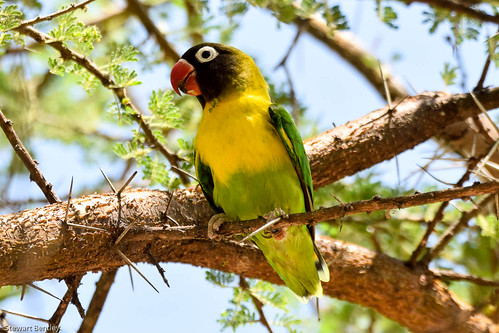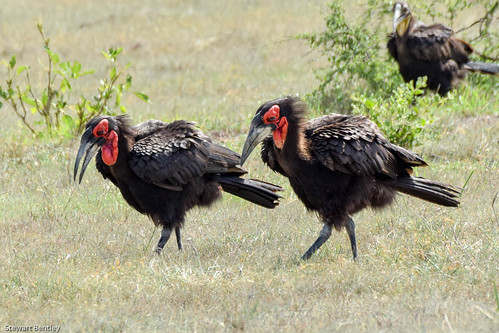The Serengeti is a vast preserve. At 5,675 square miles, it is larger than the entire state of Connecticut (or 4 times the size of Kent if you are from UK!). With a further 3,200 sq. miles protected in the surrounding Ngorongoro Conservation Area, the total is as large as Vermont or New Hampshire (or larger than Wales!). While other areas may hold the bulk of the famous Wildebeest herds at this time of year, there are many other important habitats with different and special birds and wildlife to be found. Most importantly, this is the best area for finding Leopards.
We set out, sadly minus Bill who was under the weather, at about 8am. We decided that, as it was a long mucky drive to the camp it would be better to take a picnic with us and stay out for as long a day as we wanted. This worked out well, as much of the day was lovely and sunny but huge thunderclouds gathered in mid-afternoon. So, just as we might be setting out for an afternoon game drive it poured with rain and we were nearly back at the Tented Camp.
We concentrated on areas in the centre of the Serengeti known as Seronera, leaving it much up to driver Roger to work out best routes. We had plenty of time to stop for birds and quickly began compiling quite a list. We passed clusters of kopjes (pronounced “copies”) – large isolated, weather-smoothed and rounded lumps of granite, some the size of large houses, interrupting the vast flatness of the plains. We had super views of perched Croaking and Zitting Cisticolas side-by-side in the grassy expanses where small groups of African Elephants grazed. Bushes held Magpie Shrikes, a lone Egyptian Goose sat atop a huge and high rock in one of the kopjes. Oodles of Flappet Larks performed their curious wing-clapping displays, plus a variety of weavers – White-headed Buffalos and Rufous-tailed in particular.
Early on we missed a first possible Leopard that had just come down from a tree. We motored on enjoying watching the birds and stopped by one of the Hippo pools with masses of these gargantuan beasts wallowing, some with Common Sandpiper or Black Crake using their backs as stepping stones. On the shores were shorebirds/waders such a Wood and Marsh Sandpipers, Three-banded Plovers and so on. Engrossed in these we were oblivious of a Lioness sauntering down the road towards us until another landcruiser called across to us. Very embarrassing! The Lion put on a good show, wandering over to another female previously hidden in the grass, where they greeted one another, then both wandered back to a small stream, drank and eventually walked into tall grass – lost forever.
We arrived at the Seronera Visitor Centre by midday and took the chance for a walk around the interesting Kopjes there with the Wildebeest migration timeline explained. This took us to lunch time where we ate in close company of the Rock Hyraxes, Grey-capped Social Weavers, Kenya Rufous Sparrows, D’Arnaud’s Barbets and Speckle-fronted Weavers all looking for scraps and crumbs from our picnic.
After lunch driver Roger whisked back down the road close to the airstrip where the grapevine told him there was a Leopard to be seen. In fact, on arrival there were two to be seen – a first for me in all my 36 visits. We reckoned it was a male and female courting and staying together for the few days they mate before going off to live their solitary lives again. It was a splendid sight to see these two gorgeous animals close together on what looked like very uncomfortable branches up a quite small tree – their legs and tails
dangling below them. Finishing up here we did a further gentle circuit of the side tracks up and down the little waterways and lines of Yellowbark Acacias. Another phenomenal gathering of Hippopotami was watched for a good while. At least 75 were crammed together in a foetid river, their antics of splashing, giving their huge yawning warning signs, guffawing and rubbing along together was fascinating. We also wanted to find Nile Crocodiles this afternoon as it was our best/only chance and I’d seen several whoppers in the area with the other group last week. We did well again, finding 9 in total including 2 at least of gargantuan proportions. With them by their muddy pools were first delicate Wire-tailed Swallows and Spur-winged Plovers.
We’d planned to return to the Kati-Kati Tented Camp by about 5pm, but thunderclouds gathered and threatened imminent rain, so we started making tracks for home a little earlier. With time to stop for birds we had several last good short sessions attracting birds in with owl call. Chinspot Batis, Brubru, Beautiful Sunbird, Purple Grenadiers, Red-faced Crombecs and more all obliged, close to where bright little specialised brood parasites – Steel Blue Whydah and Village Indigobird hung out looking for unsuspecting victims. We passed a close Secretarybird, several hunting Montagu’s Harriers, a lovely lone Eurasian (African) Hoopoe, a fine pair of Rufous-crowned Rollers (much scarcer than the other species of rollers here), our first woodpeckers of the trip – Nubian and Mountain Grey and kicked up small groups of roadside Fischer’s Sparrowlarks. Further very close roadside Giraffes were watched eating acacia leaves, twigs and the pin-sharp thorns while being carefully “groomed” by attendant Red-billed Oxpeckers.















































































































































































































